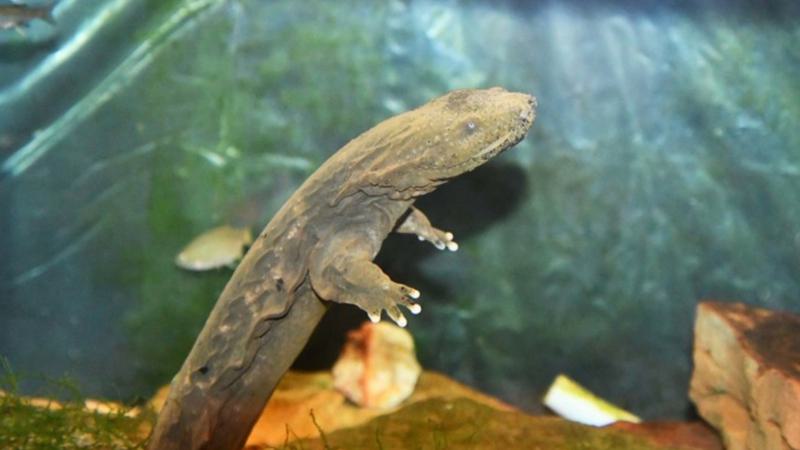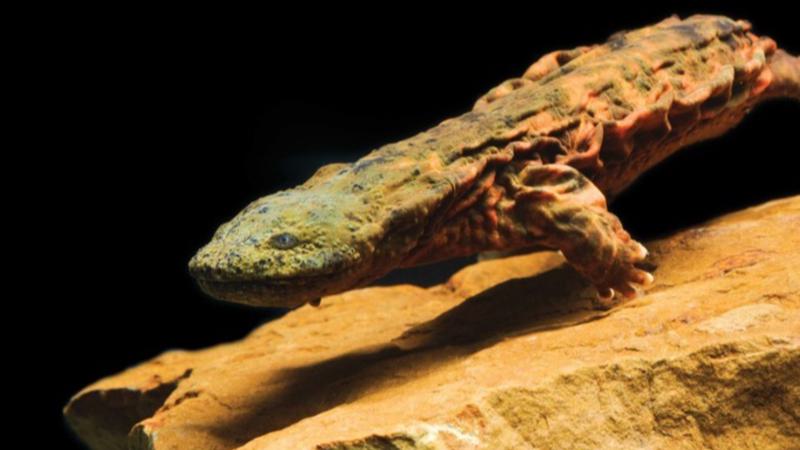Since 2008, more than 8,600 Saint Louis Zoo-raised endangered hellbenders (664 eastern and 7,977 Ozark) have been reintroduced to the wild in Missouri.
The successful 2020 reintroductions almost didn’t happen, though, due to COVID-19. The team of scientists from MDC and the Zoo collaborated on a detailed plan that focused on personal safety of team members, while also providing the best care for the hellbenders and conservation of this species.
“The process was quite a bit different this year, with a lot of careful coordination on everyone’s part,” said Briggler. Due to COVID-19 concerns, the restoration team’s priority was to reduce contact and maintain social distancing among individuals. To achieve this, animal transfers from the Zoo staff to the state herpetologist occurred in open air parking lots. Crews releasing hellbenders also were reduced and limited to two individuals per boat. “Even with these safety precautions, release quotas of hellbenders were achieved and successfully conducted,” said Briggler.
“The extraordinary teamwork by the Zoo's Herpetology, Registrar, Life Support Systems and Animal Health departments to prepare the hellbenders for reintroduction is a testament to the dedication of Zoo staff to this conservation program," said Lauren Augustine, Curator of Herpetology at the Zoo and Director of the Saint Louis Zoo WildCare Institute Ron Goellner Center for Hellbender Conservation. "Despite a pandemic, we strived for a conservation ‘win’ for these animals."
Hellbender Breeding & Conservation
The world’s first successful zoo breeding of Ozark hellbenders occurred at the Saint Louis Zoo in 2011. In 2018, another historical achievement took place at the Zoo with the hatching of second-generation zoo-bred Ozark hellbenders. Propagation of this species has continued at the Zoo, resulting in 5,531 successful hatchlings.
“This fall, despite the extra challenge, we will continue to work toward keeping sustainable populations through breeding selected individual hellbenders at the Zoo and head-starting wild-collected eggs from MDC for future releases,” said Augustine.
In addition to the breeding efforts, the Zoo also has been head-starting juvenile Ozark and eastern hellbenders, hatched from eggs collected in the wild, for future release. Currently, the Zoo has 1,397 hellbenders at the Charles H. Hoessle Herpetarium.
Once the captive-bred larvae are 2 to 8 years old, they can then be released into their natural habitat — the Ozark aquatic ecosystem. Missouri Department of Conservation biologists are monitoring the success of these released animals in the wild.
The hellbender propagation facilities at the Saint Louis Zoo include two outdoor streams that are 40 feet long and 6 feet deep. The streams house breeding groups of Ozark hellbenders from rivers in Missouri. The streams have natural gravel, large rocks for hiding and artificial nest boxes for egg laying. A nearby building houses state-of-the-art life support equipment used to filter the water and maintain the streams at the proper temperature.
In addition, three large and one small quarantined, climate-controlled rooms behind the scenes of the Zoo's Herpetarium are the headquarters for the program. The facilities recreate hellbender habitat with closely monitored temperatures, pumps to maintain highly oxygenated water, and filtration systems to provide specific water quality parameters. The animal care team meticulously cares for these animals and systems. The Zoo’s Life Support Systems team plays a critical role in constructing and maintaining these systems that provide the ideal habitat for the hellbenders at the Zoo.
The largest room includes a 32-foot simulated stream and houses a breeding group of adult eastern hellbenders.
About Hellbenders — An Endangered Species
The official endangered species of the state of Missouri, hellbenders are the largest aquatic salamanders in North America. Missouri is the only state that has both subspecies — the Ozark hellbender (Cryptobranchus alleganiensis bishopi) and the eastern hellbender (Cryptobranchus alleganiensis alleganiensis). Both are listed as state endangered in Missouri, and the Ozark hellbender also is federally endangered by the U.S. Fish and Wildlife Service.
Both Ozark and eastern hellbender populations in Missouri have declined more than 70 percent over the past 40 years. A population assessment indicated that all hellbender populations have a high risk of extinction (above 96 percent) over the next 75 years, unless populations are bolstered. Based upon these results, zoo propagation and head-starting were deemed essential to the long-term recovery of hellbenders in Missouri.
In 2001, the Ozark Hellbender Working Group of representatives from state and federal government agencies, public universities and zoos in Missouri and Arkansas launched a number of projects to staunch the Ozark hellbender’s decline. These included egg searches, disease sampling and behavioral studies to name a few. In 2004, funding from private donors, MDC, USFWS and the Zoo, covered the cost of building sophisticated facilities, including climate-controlled streams to breed the hellbender. Collection of the zoo-bred stock and eggs for propagation efforts at the Zoo occurred by MDC biologists.
The Ozark hellbender can reach lengths up to 20 inches. Also known by the colloquial names of "snot otter" and "old lasagna sides," the adult hellbender is one of the largest species of salamanders in North America, with its closest relatives being the giant salamanders of China and Japan. It has a restricted range and is only found in the cold-water rivers of south-central Missouri and adjacent north-central Arkansas. Hellbenders have broad flat heads, small lidless eyes and pronounced skin folds on the sides of their body. They can live 25+ years, and their diet includes crayfish, fish, worms and snails. Large rocks on the river bottom provide refuge and nesting sites.
In late summer and early fall, a male hellbender establishes a nest site under a large rock or within a rocky crevice and waits for a female to enter and deposit her eggs to be fertilized. The male defends its nest until the eggs hatch and resulting larvae depart the nest chamber months later.
About the Partners
The Saint Louis Zoo WildCare Institute Ron Goellner Center for Hellbender Conservation is a Saint Louis Zoo-based effort aimed at conserving native hellbender populations in Missouri.
The Missouri Department of Conservation protects and manages the fish, forest and wildlife resources of the state of Missouri. The state agency facilitates citizens' participation in resource management, sustainable fishing and hunting, and provides opportunities to experience, enjoy and learn about nature. For more information, visit mdc.mo.gov.
The mission of the U.S. Fish & Wildlife Service is to work with others to conserve, protect and enhance fish, wildlife, and plants and their habitats for the continuing benefit of the American people. For more information, visit fws.gov.



